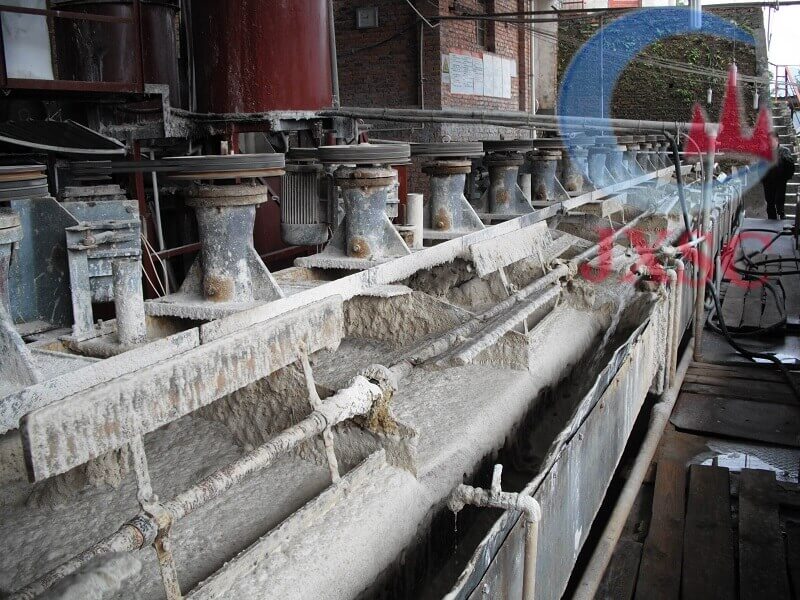There are more than ten kinds of tin-bearing minerals. At present, the tin used in the industry mainly comes from cassiterite. The primary beneficiation method of cassiterite is gravity separation because of its high density(6.4~7.1g/cm3). And since cassiterite is brittle, it is easy to slime in nature and the process of crushing, grinding, and other operations. So it is significant to use flotation to recover fine-grained cassiterite from re-election fine mud and tailings.
Cassiterite Flotation
Various fatty acids and their soaps easily capture cassiterite. Therefore, the collectors can use oleic acid, tar oil, oxidized white wax soap, nylon 1010 bottom, alkyl sulfate, alkyl sulfonate, sulfosuccinate, etc. Experimental studies have shown that cassiterite flotation with formazan, benzylic acid, and ethylene sometimes yields better results.
Collector & PH Value
- Oleic acid: pH value is generally around 9.0~9.5.
- A: pH value of the rough selection is generally 5~6, and it can reduce the pH value of the selected one to 2.5~4.0.
- When adjusting the PH value of pulp, it often uses the chemicals such as sodium carbonate and sulfuric acid.
- During the cassiterite flotation, to suppress the associated silicate ore, calcium magnesium ore, and wolframite, generally adds water glass, sodium hexametaphosphate, carboxymethyl cellulose, and oxalic acid.
The flotation material is generally gravity tailings less than 0.04mm, and the sludge less than 0.01mm is removed first. If the flotation ore is vein tin ore, it is often accompanied by sulfide deposits of iron, arsenic, antimony, lead, copper, zinc, and other metals. At this moment, it should first use the sulfide deposit’s activator to separate the sulfide deposit. And then flotation of cassiterite to avoid sulfide contamination of the cassiterite concentrate.Ti
Cassiterite Flotation Plant
The raw ore of tin ore is a high and medium-temperature hydrothermal cassiterite sulfide deposit. The composition of mineral deposits is messy. Metal deposits include pyrrhotite, magnetite, arsenopyrite, bismuthite, galena, sphalerite, chalcopyrite, etc. Non-metal deposits include carbonate, silicic acid, etc. salts, and halides. Cassiterite is yellowish-brown and black and is embedded in fine particles. Most of it is embedded in pyrrhotite in powder form, and a small part is scattered in magnetite and skarn deposits in granular form. The largest grain is 0.55mm, and the smallest is 0.002mm, generally between 0.15~0.02mm. The feed of cassiterite flotation is the tailings after desulfurization, iron removal, and shaking table processing.
The tailings of the shaking table enter the thickener for dehydration and go to the centrifuge. The centrifuge concentrate is then exhausted by the thickener and then fed into the mixing tank for adding medicine and pulping. It uses salicylic acid as a collector, sodium carbonate to adjust the pH value of the pulp to 7~8, mulberry gum as a depressant, and No. 2 oil as a foaming agent. Select the tin concentrate through the first coarse sweep, the second sweep, the third fine sweep, and the first fine sweep. The raw ore contains 1.0% 6~1.3% tin, the flotation concentrate grade is 1.3%~16%, and the recovery rate is 72%~76%.
The practice has shown that low-toxic salicylowy enteric acid can completely replace the highly toxic swollen acid, significantly reducing the environmental pollution problems in the production and use of pharmaceuticals.
The flotation function for tin extraction from tin sludge and smelting slag: it has excellent collection and selectivity. It can replace the traditional medicament benzyl swollen acid for tin selection, overcoming the defects of benzylic swollen acid, such as preciousness and high toxicity.
Proposed dosage: 400-800 g/ton feeding
The manufacturing method is 2-5% aqueous solution (weight ratio), dissolved with 40C warm water.
Scope of application: Low-grade tin sludge and smelting slag, which can make 1.5% of tin at room temperature (minimum temperature 5°C) to select more than 40% of tin concentrate powder, with a recovery rate of more than 70%.
Environmental protection function: The agent is low in toxicity, friendly to people and the environment, and easy to biodegrade.
Product Features
- Properties: The product is a pink to orange-red powdery solid, slightly soluble in water, easily soluble in alkaline solution, and stable.
- New agent for efficiency in selection.
- The pharmaceutical standard is simple, and the cost is low;
- Environmentally friendly.
Under certain conditions, the combined collectors have good selectivity. This product can form stable chelates with tin, tungsten, rare earth, copper, iron, and other metals. And it forms unstable chelates with alkaline earth metals and alkali metals. Therefore, the combination drug used in the flotation operation of some metal deposits can get a good separation effect. A combination of medications with floating weight can achieve a very excellent result. Generally, the total recovery can reach more than 85%.
LATEST PRODUCTS
Twin Screw Feeder
【Feeding Capacity】 10-160 t/h【Power】 2.2-…
Tubular Screw Conveyor
【Capacity】6-50 m3/h【Procesible Material】 …
Heavy Plate Feeder
Capacity: 100-240 m3/h Power: 15-45 kW Speed: 0…










